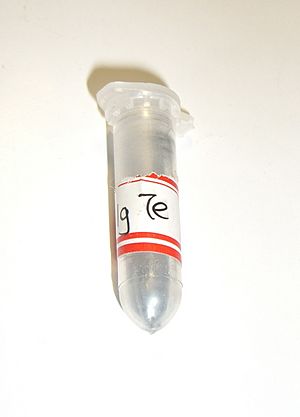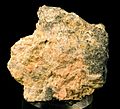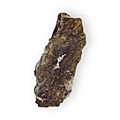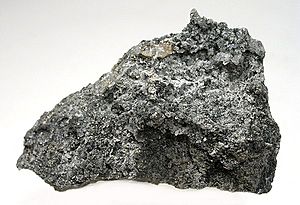Tellurium facts for kids
Tellurium is a special kind of chemical element. Its chemical symbol is Te, and its atomic number is 52. This means it has 52 protons and 52 electrons. Its mass number is about 127.6. Tellurium has 8 natural types, called isotopes. Four of these are stable, meaning they don't change over time. The other four are radioactive, which means they slowly break down. One of these radioactive isotopes lasts for an incredibly long time, longer than any other known isotope! It has a half-life of 2.2 septillion years (that's 2.2 followed by 24 zeros!).
Contents
What Tellurium is Like
Physical Features
Tellurium is a semimetal, which is a material that has properties between metals and nonmetals. It looks silver-white and is very brittle, meaning it breaks easily. When it's pure, it has a shiny, metallic look. You can easily grind it into a powder. It can also be made into a form that doesn't have a clear shape, called amorphous.
Tellurium is a semiconductor. This means it can conduct electricity, but not as well as a metal. Its ability to conduct electricity changes a little when light shines on it, much like the element selenium. When tellurium is melted, it can eat away at, or corrode, many other metals.
Chemical Features
Tellurium is not a very reactive element. It can react with active metals to form compounds called tellurides. If you burn tellurium in the air, it forms tellurium dioxide. It can be changed even more to tellurium trioxide. Tellurium does not rust or corrode easily.
Tellurium's chemical behavior is similar to selenium and sulfur. However, tellurium's compounds are usually more reactive, while the element itself is less reactive. It doesn't dissolve in most acids. But it will dissolve in strong sulfuric acid, making a special red tellurium ion.
Tellurium Compounds
Tellurium forms many different chemical compounds. In these compounds, tellurium can have different "oxidation states," which describe how it shares electrons. These states are -2, +2, +4, and +6.
- -2 compounds: These are usually found in tellurides. They are strong "reducing agents," meaning they can give electrons to other chemicals. Tellurides are often the main source of tellurium found in nature. Most natural tellurides are not pure, so they are less reactive.
- +2 compounds: These are rare and found in some tellurium halides, like tellurium(II) chloride.
- +4 compounds: These are found in tellurites and tellurous acid. They are weak "oxidizing agents," meaning they can take electrons from other chemicals. They can be changed back into tellurium. Tellurites are made by mixing tellurium dioxide with a metal oxide.
- +6 compounds: These are found in tellurates and telluric acid. They are very strong oxidizing agents. Tellurates are made by mixing telluric acid with metal oxides.
Where Tellurium is Found
Tellurium is a very rare element on Earth. There is about 14 times more silver in the ground than tellurium! Sometimes, tellurium is found by itself as an element. But most of the time, it's found in compounds called tellurides.
One important type is gold tellurides, like Calaverite. These are valuable ores because they contain both tellurium and gold. There's a famous story from a gold rush where miners didn't realize this gold ore was valuable. They used it as a simple filler material! Later, it was discovered to be gold telluride, which started another gold rush.
How Tellurium is Made
One way to get tellurium is from gold telluride. You can dissolve the gold telluride in strong sulfuric acid. The tellurium dissolves and makes a red liquid, while the gold sinks to the bottom.
A more common way to get tellurium from tellurides is by heating them. The tellurides are heated with sodium carbonate and air. This creates a compound called sodium tellurite. Often, other similar compounds called selenites are mixed in. These are separated by adding sulfuric acid. The selenites stay dissolved, but the tellurites turn into tellurium dioxide. Then, the tellurium dioxide is mixed with sulfur dioxide dissolved in sulfuric acid to make pure tellurium metal. This tellurium can then be melted and shaped into bars.
What Tellurium is Used For
The main use for tellurium is in alloys. Alloys are mixtures of metals. Tellurium is added to iron, copper, and lead alloys. It makes these metals easier to shape with machines. It also makes lead stronger and more resistant to damage from sulfuric acid.
Tellurium is also used in cadmium telluride solar cells. These cells are very good at turning sunlight into electricity. It can be mixed with cadmium and mercury to make mercury cadmium telluride. This is a semiconductor that can sense infrared light.
Tellurium is used in some rewritable optical discs, like CDs or DVDs that you can record on multiple times. Lead telluride is used in another type of infrared sensor.
It's also used to add color to ceramics. Tellurium helps make fiberglass that is used in telecommunications, like for phone and internet cables. It helps the light travel better. It's also used in special blasting caps that delay explosions. Tellurium can even be used to make rubber harder.
Tellurium and Living Things
Tellurium is not really used by living things. However, some fungi can use tellurium instead of selenium or sulfur. Most organisms can process tellurium in their bodies to create a chemical called dimethyl telluride. This chemical smells like garlic! So, if someone eats a tellurium compound, their breath might smell like garlic.
Safety with Tellurium
Tellurium is very toxic, which means it can be harmful if you come into contact with it.
More to Explore
- Tellurium compounds
| Periodic table | |||||||||||||||||||||||||||||||||||||||||
|---|---|---|---|---|---|---|---|---|---|---|---|---|---|---|---|---|---|---|---|---|---|---|---|---|---|---|---|---|---|---|---|---|---|---|---|---|---|---|---|---|---|
| H | He | ||||||||||||||||||||||||||||||||||||||||
| Li | Be | B | C | N | O | F | Ne | ||||||||||||||||||||||||||||||||||
| Na | Mg | Al | Si | P | S | Cl | Ar | ||||||||||||||||||||||||||||||||||
| K | Ca | Sc | Ti | V | Cr | Mn | Fe | Co | Ni | Cu | Zn | Ga | Ge | As | Se | Br | Kr | ||||||||||||||||||||||||
| Rb | Sr | Y | Zr | Nb | Mo | Tc | Ru | Rh | Pd | Ag | Cd | In | Sn | Sb | Te | I | Xe | ||||||||||||||||||||||||
| Cs | Ba | La | Ce | Pr | Nd | Pm | Sm | Eu | Gd | Tb | Dy | Ho | Er | Tm | Yb | Lu | Hf | Ta | W | Re | Os | Ir | Pt | Au | Hg | Tl | Pb | Bi | Po | At | Rn | ||||||||||
| Fr | Ra | Ac | Th | Pa | U | Np | Pu | Am | Cm | Bk | Cf | Es | Fm | Md | No | Lr | Rf | Db | Sg | Bh | Hs | Mt | Ds | Rg | Cn | Uut | Fl | Uup | Lv | Uus | Uuo | ||||||||||
|
|||||||||||||||||||||||||||||||||||||||||
Images for kids
-
A CdTe photovoltaic array (solar panels)
See also
 In Spanish: Telurio para niños
In Spanish: Telurio para niños











